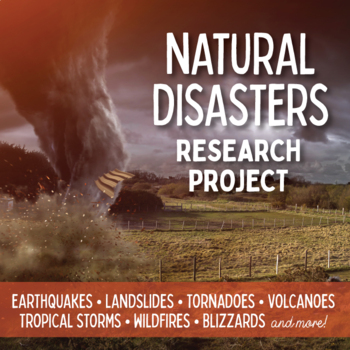Natural Disasters Research Project with Choice Board and Graphic Organizer
Creative Access
1.5k Followers
Grade Levels
Not Grade Specific
Subjects
Resource Type
Standards
NGSSMS-ESS3-2
NGSS4-ESS3-2
Formats Included
- PDF
Pages
7 pages
Creative Access
1.5k Followers
What educators are saying
Thanks for creating this resource. I was able to use this to supplement my reading curriculum's unit about Natural Disasters.
A good project to end our unit with. Students were engaged looking up the places and events that were mentioned, and me and other teachers in the room could talk about disasters that we ourselves remembered.
Also included in
- Unexpected absence? No time to plan? Going to be gone for several days? This bundle of student-directed individual work opportunities comes to the rescue. You'll never need to stress about sub plans again.Every included resource works well for students to complete on their own, with the help of a viPrice $60.00Original Price $82.00Save $22.00
- This bundle of resources provides multiple days of easy-to-plan student-led research projects, which can be spread across the course of the school year. Each resource includes a project choice board, a graphic organizer, and an extensive list of potential topics to research.This bundle currently incPrice $23.00Original Price $26.00Save $3.00
Description
Let your students direct their own research about severe weather, volcanoes, tornadoes, earthquakes, hurricanes, wildfires, and blizzards with this natural disasters research project! Extend their learning on weather, plate tectonics, environmental factors, and more. Open your students' eyes to current and historical events with important environmental, cultural, and economic impacts.
This resource includes:
- A list of more than 300 natural disasters that have shaped history and the environment around the world. Each disaster includes a name, location, and year to assist with research. Natural disasters are placed into the following categories: earthquakes, landslides and mudslides, tornadoes, volcanic eruptions, lake eruptions, meteorite strikes, tropical storms, wildfires, and blizzards.
- A research outline where students can organize information they find about their natural disaster while researching. This is especially helpful for students with IEPs and English Language Learners. This outline can be used as a stand-alone graphic organizer or in conjunction with the project choice board.
- A project choice board which describes 4 creative projects students can complete to share their research about their natural disaster. Projects are largely open-ended and range from audiovisual formats to critical thinking to projects that involve hand-created artwork. Allow your students to choose the project that best fits their personal creative strengths or their natural disaster.
Click "View Preview" to view the resource before purchase.
You may also like:
Total Pages
7 pages
Answer Key
N/A
Teaching Duration
N/A
Report this resource to TPT
Reported resources will be reviewed by our team. Report this resource to let us know if this resource violates TPT’s content guidelines.
Standards
to see state-specific standards (only available in the US).
NGSSMS-ESS3-2
Analyze and interpret data on natural hazards to forecast future catastrophic events and inform the development of technologies to mitigate their effects. Emphasis is on how some natural hazards, such as volcanic eruptions and severe weather, are preceded by phenomena that allow for reliable predictions, but others, such as earthquakes, occur suddenly and with no notice, and thus are not yet predictable. Examples of natural hazards can be taken from interior processes (such as earthquakes and volcanic eruptions), surface processes (such as mass wasting and tsunamis), or severe weather events (such as hurricanes, tornadoes, and floods). Examples of data can include the locations, magnitudes, and frequencies of the natural hazards. Examples of technologies can be global (such as satellite systems to monitor hurricanes or forest fires) or local (such as building basements in tornado-prone regions or reservoirs to mitigate droughts).
NGSS4-ESS3-2
Generate and compare multiple solutions to reduce the impacts of natural Earth processes on humans. Examples of solutions could include designing an earthquake resistant building and improving monitoring of volcanic activity. Assessment is limited to earthquakes, floods, tsunamis, and volcanic eruptions.







